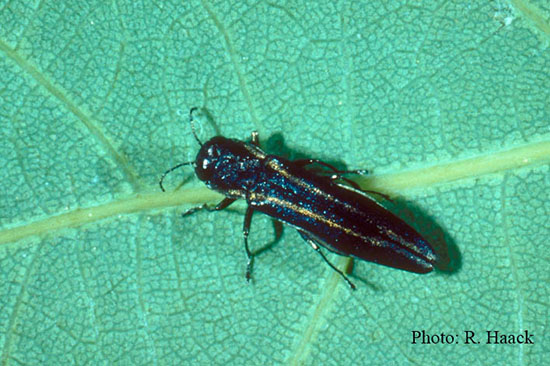Issue 4, May 27, 2014
Twolined Chestnut Borer
Two-lined chestnut borer, Agrilus biliniatus, attack primarily oak and chestnut, but occasionally attack beech. They prefer white, black, red, scarlet, bur, and chestnut oaks. Although they primarily attack oaks that have been damaged or are under stress, they can attack healthy trees. It is common for twolined chestnut borer to become numerous in areas with gypsy moth infestations, causing the trees to die from the top down over two to three years. Be watchful for this borer in gypsy moth infested areas of NE Illinois. Similarly, nursery trees are commonly infested, which is associated with the stress of transport and adaptation to site after transplanting.

Twolined chestnut borer adult
The first signs of infestation are wilted foliage on scattered branches in late summer. Frequently, these appear initially as the terminal foot or so of leaves dying. Remove some branches and check for larval tunneling in the cambium. Botryosphaeria fungal cankers can cause similar oak tip dieback. The leaves will die but stay attached to the tree for weeks or months before dropping. The affected branches will die and not leaf out the following year.

Twolined chestnut borer larval damage.
Damage is caused by larvae tunneling in the cambium, making winding tunnels. The larvae are slender, flattened, whitish, and grow to about one inch long. There will also be distinctive D-shaped adult exit holes about 1/8 inch wide in the bark. Adult beetles are slender, black, about ½ inch long, with two golden stripes on their back that are commonly indistinct. Twolined chestnut borer, bronze birch borer, and emerald ash borer are all in the same genus, so identifying characteristics are similar.
Adult beetles are most active from late April in southern Illinois to early June in northern Illinois. They are attracted to the sunny sides of the trunk. Insecticidal control is timed for adult emergence, achieved by spraying the lower four-and-one-half feet of trunk with imidacloprid. Control can also be achieved by trunk or soil injection or soil drenches as with emerald ash borer. Although this insect is very damaging in some states, it is rarely a problem in properly maintained trees in Illinois landscapes. (Phil Nixon)
Author:
Phil Nixon